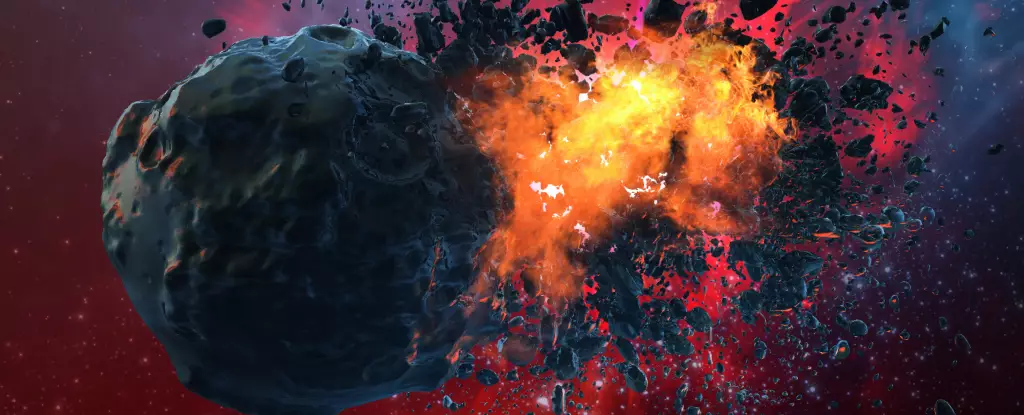In the realm of cosmic events, one of the more alarming possibilities is a large asteroid colliding with Earth. The likelihood of such an event occurring has gained considerable attention, especially with recent readings indicating a 3.1% chance that the asteroid known as 2024 YR4 may strike on December 22, 2032. This prospect, while concerning, has ignited discussions around humanity’s preparedness and the effectiveness of planetary defense mechanisms as proposed by experts in the field. The elevation in risk has prompted provocative dialogues about potential countermeasures, ranging from advanced technology to preparedness strategies.
The recent data suggesting a heightened probability of encounter with asteroid 2024 YR4 marks a pivotal moment for astronomers and planetary defense professionals alike. Despite these figures, Richard Moissl, head of the European Space Agency’s planetary defense office, offers a clear message: “Don’t panic.” This refrain is not merely a comforting platitude; it is a call to rational action. As predictive models refine and new data emerges, the estimated chances of impact could fluctuate significantly before more accurate predictions are established. Such oscillations underline the importance of continuous observation rather than knee-jerk reactions.
However, should the probability progressively increase, experts assert that humanity’s ability to defend against an asteroid attack should not be underestimated. Awareness is a critical element in shaping public perception; recognizing that we are not merely passive observers but active participants in cosmic safeguarding can help foster both resilience and innovation in crisis management.
Planetary defense strategies have evolved from theoretical underpinnings to practical applications. NASA’s Double Asteroid Redirection Test (DART), executed in 2022, marked a significant milestone in planetary defense by successfully altering the orbit of the asteroid Dimorphos through a kinetic impactor—a concept previously confined to science fiction. This test demonstrated that deliberate human intervention can redirect celestial bodies, providing a solid framework for future asteroid engagements.
Several other non-invasive strategies have emerged as potential solutions for grappling with incoming threats. The gravity tractor method exemplifies an ingenious approach that relies on gravitational influence: a spacecraft would position itself near an asteroid to exert a gravitational pull without physical contact. This method is less conspicuous than brute-force options and would require timely action to have a substantial effect.
Additionally, innovative ideas, such as increasing an asteroid’s reflectivity through painting, have stirred interest among scientists. While such measures may seem simplistic, they embody a larger, strategic focus on subtle manipulation rather than overt destruction.
Nonetheless, there exists a more contentious option: nuclear intervention. Various scenarios have been theorized, notably the idea of detonating a nuclear device in proximity to the asteroid rather than embedding it within the rock, as depicted in Hollywood films like “Armageddon.” While lab experiments indicate that vaporizing the surface of an asteroid using x-ray emissions could achieve a deflection of its trajectory, this approach raises substantial ethical, legal, and political dilemmas, casting uncertainty over its viability.
Despite these challenges, experts contend that when time allows, non-nuclear methods should be prioritized. The hope is that, through collaboration and innovative engineering, an asteroid can be redirected without resorting to destructive measures. The implication of a nuclear response presents a daunting reality—there exists a risk of fragmenting the asteroid into potentially hazardous pieces, counteracting any defensive gains.
Should all countermeasures fail and an asteroid impact become imminent, a robust preparatory plan is essential. With nearly eight years remaining before the predicted date, experts emphasize the significance of time in crafting effective evacuations and safety protocols, particularly in urban centers that could be vulnerable to an asteroid strike. Moissl denotes that, while the scenario is certainly grave, the asteroid at stake is not classified as a “planet killer.” It is estimated that the worst-case scenario could pose significant risk to a city rather than global catastrophe.
While the threat of an asteroid collision is real, our current understanding and reliance on adaptive strategies embolden humanity’s response. Awareness, scientific innovation, and global collaboration will guide our efforts in addressing potential dangers from the cosmos, ultimately safeguarding our planet’s inhabitants. As Moissl aptly noted, “Seven and a half years is a long time to prepare,” and that’s precisely what humanity must focus on—preparation, innovation, and resilience.

